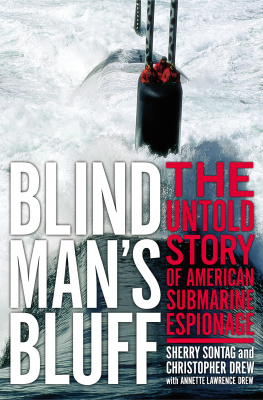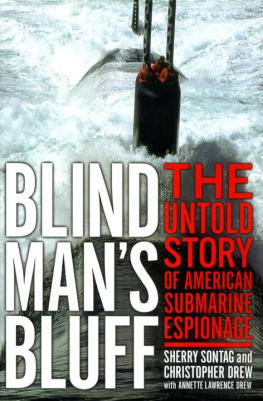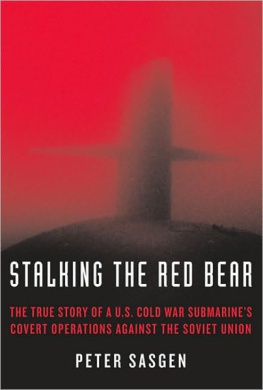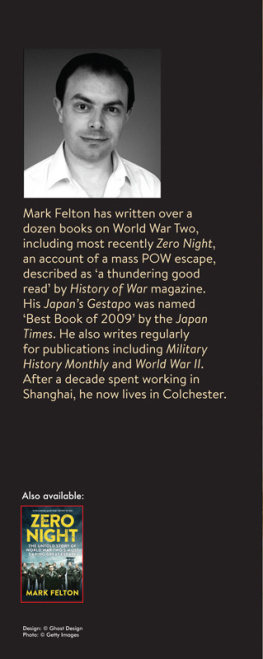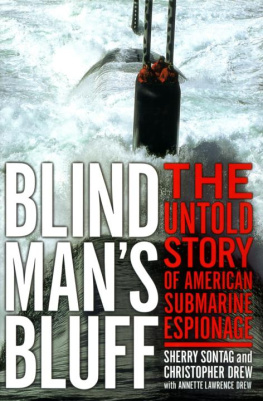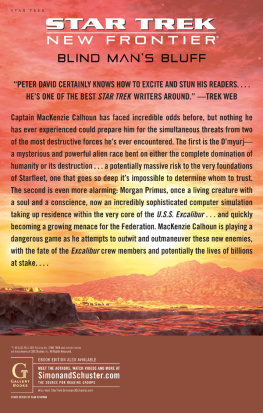
OUTSTANDING ACCLAIM FOR
BLIND MANS BLUFF
Packed with real life adventures that Tom Clancy could only have guessed at.... More than a collection of sea stories. It reveals how submarine operations during the cold war had a profound impact on strategic decisions made in the Kremlin and Washington.... With Naval agents on their heels... Sherry Sontag and Christopher Drew have made a successful end run around stacks of secrecy oaths and the locked lips of the Silent Service to make public some of the most astounding military operations of the cold war.... Lock the doors and draw the shades, because this book is a well written, highly readable account of man and machine working together to do the impossible for the highest of stakes.
Washington Monthly
Vividly told, impressively documented, and persuasively argued.
New York Times
The veterans of the Silent Service are silent no more.
John Lehman, former secretary of the Navy,
Wall Street Journal
The book is filled with specifics... but thankfully not presented in the dry techno-speak of many military histories. This one is very human and easy to read.
Washington Post
A tale that has the Navy refusing to comment and retired submariners rejoicing that their story is finally being told.... Espionage missions described in this book are among the most sensitive and secret intelligence operations of the cold war. Most have never been described in detail, if at all, and the Navy to this day refuses to acknowledge them publicly.
Associated Press
Gripping.
Publishers Weekly
Its almost impossible to make up stuff this good.
John Weisman, author of the Rogue Warrior Series
Excellent history... that reads like a Tom Clancy novel.
Booklist
Hard-core investigative reporting at its crispest.... The stories are exciting, the personalities border on the eccentric, and the constant turf battles among various U.S. government agencies in those often top-secret submarine activities make for intriguing reading.
Library Journal
Exciting.
Denver Post
Strong stuff!... Highly recommended.... A compelling testimony to the courage and ingenuity of the submariners and the intelligence wizards and operators who made use of this weapon during the cold war and up to this day.
Roy Jonkers, AFIO Executive Director,
Weekly Intelligence Notes
As exciting as early Tom Clancy novels... engrossing.... Highly recommended for everyone with an interest in submarines or intelligence.
Sea Power
An immensely readable look at some of the blackest secrets of the cold war, as U.S. and Soviet subs engage in subterfuge as intriguing as a thriller novel.
Providence Journal-Bulletin
Impressive... the authors managed to capture the flavor of submarine life, the innovation and ingenuity of men who have to fix complex equipment when there is no supply line, the command structure that seems casual to an outsider but which works better in an undersea environment than the more rigid arrangements on surface or shore commands.
New London Day (CT)
The most comprehensive look at the work of these intrepid sailors... A celebration of their ingenuity and valor.
Baltimore Sun
The authors write of top-secret operations to tap underwater Soviet cables, recover a live H-bomb mistakenly lost on the ocean floor, and steal a Russian sub. Better yet, all of it is trueand revealed on these pages for the first time.
Investors Business Daily

Table Of Contents
To the men who lived these tales,
and especially to those who shared them with us.
After all, submarining has always
been a game of blind mans bluff.
A top submarine admiral
And every man on board knew,
When the going got rough,
In this game of Blind Mans Bluff,
Somehow hed pull her through.
Lyrics from The Ballad of Whitey Mack,
an ode to a submarine captain by
Tommy Cox, submariner and spook
PROLOGUE
There was something about Commander Charles R. MacVean that had a way of inspiring legend. It wasnt the way he looked: tall, a little chunky, and in his late thirties already crowned by a thatch of thinning gray hair. It was his sense of humor and his humanity. This was a man who could stand beneath a hatch after being doused with a column of water, deadpan and still chewing his dripping pipe. This was also the man who had just led the nuclear attack submarine USS Seawolf on one of the most dangerous operations of the cold war. She had slipped inside a Soviet sea and eavesdropped on the enemy in a way most other subs could never dare. Now, finally home, MacVean was enjoying the chance to get some sleep.
The phone rang. MacVean snapped awake and checked the time, 2:00 a.m. The call was from Navy headquarters in Washington, D.C., and the voice on the other end of the line belonged to a somewhat embarrassed and very confused Navy officer.
Theres a sailor from your ship at a bar called the Horse and Cow, he said, and hes trying to call the president to tell him what a great job you did and how great you are. Could you go get him out of the phone booth?
MacVean knew just where the Horse and Cow was, as did all of his men. This was the submariners haunt in Vallejo, California, a darkened place decorated with pieces of just about every sub that ever steamed through the Pacific toward the Soviet Union, a place where men built themselves up for what they would face out at sea and where they celebrated survival when they made it home. The commander rousted his chief of the boat, and together they drove over to the spot isolated along a highway service road and pulled into a parking lot that was more potholes than pavement. Sure enough, they found a somewhat inebriated member of Seawolfs crew, lodged in a phone booth, still trying to talk his way past a White House operator. MacVean got his man off the phone, then bought him a beer. MacVean was that kind of captain. Besides, he knew the guy deserved one. They all did.
This happened in the mid-1970s, but it could have occurred at almost any time during the cold war. MacVean and his men were, after all, part of an intelligence operation unlike any other in the annals of American history. For more than four decades, under the cover of classifications even higher than top-secret, the United States sent tens of thousands of men in cramped steel cylinders on spy missions off the rugged coasts of the Soviet Union. There, the job was to stay hidden, to gather information about the enemys intentions and its abilities to wage war at sea. By their very nature, submarines were perfect for this task, designed to lurk nearly silent and unseen beneath the waves. They quickly became one of Americas most crucial spy vehicles.
No other intelligence operation has embraced so many generations of a single military force, no other has consistently placed so many Americans at risk. As many as 140 men on each sub, several subs at a time, nearly every man who ever served on a U.S. attack submarine was sent to watch Soviet harbors and shipyards, monitor Soviet missile tests, or shadow Soviet subs. Several boats, such as Seawolf, were specially equipped to tap cables or retrieve pieces of Soviet weapons that had been fired in tests and had fallen to the bottom of the sea. No one was involved who didnt volunteer.
Next page
